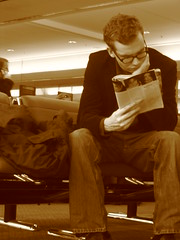Audio lomography
Ever since I first heard about it last November, I’ve liked the idea of lomography – people documenting their lives with toy cameras. Moreso than the lo-tech approach, it’s the philosophy that appeals to me:
Lomography emphasizes shoot-from-the-hip photography. Over-saturated colors, lens artifacts, and exposure defects are used to produce artistic, abstract effects and are prized by practitioners. Others use the technique to document everyday life because the small camera size and ability to shoot in low light encourages candid photography, photo reportage and photo vérité. The lomography credo "don't think, just shoot" encourages spontaneity, close-ups, ubiquity, and randomness.This is cool. Problem is, I’m not a very visual guy. So I’ve been thinking about how the principles of lomography can be applied to audio. Can photographic techniques be applied to the temporal world of radio? I think so. The aim of lomography is to celebrate and document life by viewing it in new and exciting ways. Radio producers would do well to try this out – to start hearing the world in new and exciting ways. There are lots of ways to tell an audio story. Why not invent a new one? So then, after a week of thought and experimentation, I’ve drawn up some thoughts about “audio lomography,” based on (and borrowing heavily from) the 10 Golden Rules of Lomography. Here they are:




1 Comments:
At 11/29/2004 10:37:00 PM, Carmody Wilson said…
Carmody Wilson said…
This sounds great...hmmm was that what you were doing when we were in the food court? Are you some kind of audio prevert?
Post a Comment
<< Home